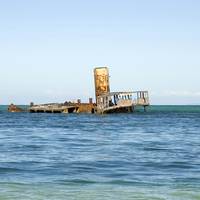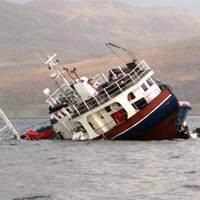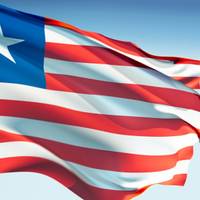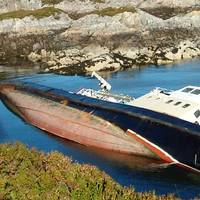Mexico Ratifies IMO Legal Conventions
The maritime authorities of the Government of Mexico have agreed to place a high priority on ratifying three important International Maritime Organization (IMO) legal conventions, following a workshop in Mexico City.Mexico has said it will work towards ratifying the 2003 Fund Protocol, the 2001 Bunkers Convention and the 2007 Nairobi Wreck Removal Convention. It will also consider accession to the 2010 HNS Convention. The Governments of Guatemala and Honduras expressed similar intent.Both the Fund Protocol and the Bunkers Convention deal with compensation following oil spills from ships. Together with the 1992 Civil Liability and Fund Conventions…
IMO Promotes Wreck Removal
International Maritime Organization (IMO) is continuing its work to promote ratification of the international treaty covering wreck removal – at the 10th Maritime Salvage & Casualty Response Conference in London, this week (11-12 September).Depending on its location, a shipwreck may be a hazard to navigation, potentially endangering other vessels and their crews.The Nairobi Convention covers the legal basis for States to remove, or have removed, shipwrecks, drifting ships, objects from ships at sea, and floating offshore installations.The Nairobi convention includes provisions for coastal States to take action in cases of container fires on board ships…
Canada Accedes to Nairobi WRC
Hazardous shipwrecks can cause many problems. Depending on its location, a wreck may be a hazard to navigation, potentially endangering other vessels and their crews.International Maritime Organization (IMO)'s Nairobi Wreck Removal Convention (WRC) goes some way to resolving these issues. It covers the legal basis for States to remove, or have removed, shipwrecks, drifting ships, objects from ships at sea, and floating offshore installations.The Nairobi International Convention on the Removal of Wrecks, 2007, was adopted by an international conference held in Kenya in 2007. The Convention provides a set of uniform international rules…
IMO Addresses Wreck Removal Challenges
A ship wreck can be a hazard to navigation. Other vessels and their crews can potentially be endangered, and, depending on the nature of the cargo and remaining fuel on board, a wreck may also cause damage to marine environments and other coastal interests. Then there is the issue of costs and risks involved in marking and removing hazardous wrecks.To help resolve these issues, International Maritime Organization (IMO)'s Nairobi Wreck Removal Convention, covers the legal basis for States to remove, or have removed, shipwrecks, drifting ships, objects from ships at sea, and floating offshore installations.To spread knowledge of the specific aspects of the Convention…
International Maritime Prize Goes to Birgit Sølling Olsen
The prestigious International Maritime Prize for 2017 has been presented to Mrs. Birgit Sølling Olsen, former Deputy Director-General of the Danish Maritime Authority.International Maritime Organization (IMO) Secretary-General Kitack Lim presented the prize on Thursday (6 December) at the annual IMO Awards ceremony,“Mrs. Olsen has had a distinguished career in the maritime field and made an outstanding contribution to the objectives of IMO. Her comprehensive knowledge of maritime law is combined with a deep understanding of the business aspects and growth potential of the maritime industry,” Mr Lim said.The International Maritime Organization (IMO) Council decided in July to award the Prize to Mrs.
Nairobi Wreck Removal Convention Updated
Hazardous ship wrecks can cause many problems. Depending on its location, a wreck may be a hazard to navigation, potentially endangering other vessels and their crews. It may also cause substantial damage to the marine and coastal environments, depending on the nature of the cargo. On top of this, there is the issue of costs involved in marking and removing hazardous wrecks. International Maritime Organization (IMO)'s Nairobi Wreck Removal Convention goes some way to resolving these issues. It covers the legal basis for States to remove, or have removed, shipwrecks, drifting ships, objects from ships at sea, and floating offshore installations.
Wreck Removal Challenges
The issue of how to legally remove hazardous wrecks at sea has been in the spotlight at the Salvage & Wreck London 2017 Conference (7 December). International Maritime Organization (IMO)’s Jan De Boer took part in a panel discussing the challenges surrounding wreck removal and provided an update on the Nairobi Wreck Removal Convention. The Convention provides the legal basis for States to remove, or have removed, shipwrecks that may threaten the safety of lives, goods and property at sea, as well as the marine environment. It applies to shipwrecks, objects from ships at sea, drifting ships and floating offshore installations. Under the treaty, shipowners are strictly liable for costs of locating, marking and removing hazardous wrecks.
Wreck Removal Treaty Comes into Force in Singapore
Skuld Singapore has reminded all members that Singapore has ratified the Wreck Removal Convention (WRC) which entered into force in Singapore on 8 September 2017. "As members will be aware, the WRC requires among other matters owners of ships over 300 GT to have in place insurance to cover the costs of wreck removal. Skuld, like all the clubs within the International Group, has appropriate wreck removal cover available to their members," said a statement from the international mutual marine insurance company. Owners of ships that call at ports of States which have already ratified the WRC and which mandate production of an insurance certificate (the "Blue Card") as a port entry requirement…
Nairobi: Understanding Wreck Removal
A meeting of salvage and wreck professionals in London, United Kingdom has been introduced to International Maritime Organization (IMO)'s Nairobi Wreck Removal Convention. The treaty provides the legal basis for States to remove, or have removed, shipwrecks that may threaten the safety of lives, goods and property at sea, as well as the marine environment. IMO’s Jan De Boer outlined the Convention’s key provisions in a session on “Operating within guidelines, conventions and authorities’ requirements” at the 19th Salvage & Wreck Removal Conference (7-9 December). These provisions include uniform international rules for the prompt and effective removal of wrecks located beyond territorial seas, and optional application of the rules in countries’ territories, including territorial seas.
Wreck Removal Convention Ratified by Finland

Finland has become the 32nd State to ratify the International Maritime Organization’s (IMO) Nairobi International Convention on the Removal of Wrecks. The treaty, which entered into force in 2015, provides the legal basis for states to remove, or have removed, shipwrecks that may threaten the safety of lives, goods and property at sea, as well as the marine environment. The convention was adopted in 2007 and its contracting states currently represent just over 60 percent of the world's merchant fleet tonnage.
Nairobi Wreck Removal Convention Explained
The International Maritime Organization (IMO) treaty covering wreck removal is on the agenda at the 7th Maritime Salvage and Casualty Response Conference in London (7-8 September). IMO’s Jan de Boer gave an insight into the Organization’s Nairobi Wreck Removal Convention, which provides the legal basis for States to remove, or have removed, shipwrecks that may threaten the safety of navigation, the marine environment as well as the coastline or related interests. The treaty also provides uniform international rules for the prompt and effective removal of wrecks located beyond territorial seas, and optional application of the rules in countries’ territories, including territorial seas.
Salvage & Wreck Removal Conference Presents an Upbeat Mood
The verdict at the 5th India Marine Salvage and Wreck Removal Conference of Hinode held this time in Mumbai last week was clear and unanimous. The presentations as well as the deliberations highlighted an upbeat atmosphere indicating the growing prospects for salvors on the India’s 7516 KM of coastline and in the surrounding area. The scenario depicts numerous options according to the presentations which brought out issues and insights that made prospects look bright in the coming months and with the monsoon round the corner, players could finally make it big. The introductory session underlined the fact that India became a signatory to International Convention of Wreck Removal Convention in 2010 and the convention has been in force from 14th April 2014.
Limitless Salvage

Whether driven by treasure hunting or environmental protection, the days of forgotten wrecks, even at great depths, is past. It seems like every month we see reports of long-lost maritime wrecks being discovered on the ocean bottom and treasures being salvaged from great depths. We also hear regularly of oil being recovered from sunken wrecks. There is now no practical limit to the ability to recover objects from the sea floor, regardless of depth, currents, weather, or other obstacles. The only existing obstacle seems to be financing - and costs are decreasing regularly.
New Marine Pollution Instrument

The Nairobi International Convention on the Removal of Wrecks, which entered into force internationally in April this year, provides another tool in the armory of global treaties adopted by the International Maritime Organization (IMO) which are intended to help prevent pollution from ships and minimize any damage caused. IMO’s Jan De Boer gave a presentation on the “Nairobi Wreck Removal Convention: A new marine pollution instrument” at a seminar on marine pollution in London (June 25) organized by Lloyd’s Maritime Academy.
Nairobi Wreck Removal Convention Enters into Force

The Nairobi International Convention on the Removal of Wrecks enters into force on Tuesday, April 14, 2015. The Convention places strict liability on owners for locating, marking and removing wrecks deemed to be a hazard and makes State certification of insurance, or other form of financial security for such liability, compulsory for ships of 300 gt and above. It also provides States Parties with a right of direct action against insurers. The Convention fills a gap in the existing…
Palau Reports Increase in WRC Applications
Palau International Ship Registry (PISR) has received a high volume of applications from owners looking to have the correct documentation in place prior to the imminent entry into force of the Nairobi Wreck Removal Convention. Marisabel Arauz Park, Palau International Ship Registry’s technical manager, said, “The high number of applications from owners wanting to be compliant before the convention’s entry into force on April 14 is indicative of the shipowning community’s increasing confidence in Palau as a reliable, responsible flag. “Although we are a relatively new register, our fleet is expanding rapidly and we now have regional offices in 15 countries…
Liberia Leads on Wreck Removal Certification

The Liberian Registry said delivery of Wreck Removal Convention certificates is now faster and more convenient for shipowners following the launch if its new online application system. The system was set up to expedite shipowners’ compliance with the requirements of the Nairobi International Convention on the Removal of Wrecks 2007 (WRC), which comes into force on April 14, 2015, requiring owners of vessels of 300 gt and above to carry a certificate as evidence of compliance that insurance or financial security is in place to cover their liability under the convention.
Wreck Removal Convention Inforce From April
The insurance and certification requirements of the Convention on the Removal of Wrecks become effective this April. In this connection, the Danish Maritime Authority has a request for Danish companies and shipowners. All Danish ships of or above 20 GT (gross tonnage) must take out insurance or other financial security to cover the owner’s liability in connection with the removal of wrecks. The ships must not engage in trade at all if such insurance or other financial security is not held. The regulations apply to all types of ships – not just merchant ships, but also fishing vessels, passenger ships and recreational craft. Large ships of or above 300 GT must carry a certificate on board, certifying that they have the required insurance/financial security.
Liberia Joins Nairobi Wreck Removal Convention

Liberia acceded to the Nairobi International Wreck Convention on the Removal of Wrecks, 2007, on January 8, 2015, and thus becomes the largest flag state party to the convention. The Nairobi Convention covers shipwrecks that could have a potential adverse effect on the safety of lives and property at sea, as well as the marine environment. When it enters into force on April 14, 2015, it will fill a gap in the existing international legal framework by providing the first set of uniform international rules aimed at ensuring the prompt and effective removal of wrecks.
Denmark's Signature Enables Wreck Removal Convention
Denmark is the tenth country to accede to the Wreck Removal Convention which means that it will take effect on 14 April 2015. The Danish Maritime Authority informs that a minimum of ten countries must accede to a convention in order to put it in force. The most important new provision of the Convention is that it ensures improved possibilities of having the expenses incurred in connection with the removal of wrecks covered on the ship owner’s account. Thus, the risk of the public sector having to pay is reduced. The regulations mean that the ship’s owner becomes liable for the removal of a wreck following a marine accident. Ships with…
Wreck-Removal Convention to Enter into Force

The Nairobi International Convention on the Removal Wrecks will enter into force on April 14, 2015 following the deposit, on April 14, 2014, of an instrument of ratification by Denmark, with the International Maritime Organization (IMO). Among several provisions, the convention will place financial responsibility for the removal of certain hazardous wrecks on shipowners, making insurance, or some other form of financial security, compulsory. Denmark became the 10th country to ratify the convention, thereby triggering its entry into force exactly 12 months later.
EC Notes Safety Progress, Highlights Needed Improvement
Some EU Member States are struggling to meet their commitment to ratify international maritime conventions, according to a European Commission report (EC) on compliance with flag state requirements. Vice-President Siim Kallas, EU transport commissioner, said, "I am heartened that most coastal Member States are taking their obligations seriously as flag states. Current EU rules promote maritime safety and set a high standard for EU flag states by requiring them to undergo a peer review of their maritime administration and develop and implement a certified quality management system for their operations. Portugal, Ireland and all landlocked flag states except Luxembourg have failed to do so.
GOL SALVAGE Taking on the Global Giants
In the three years since its launch GOL Salvage Services Ltd., having forayed into a domain traditionally commanded by global players has today become a force to reckon with. GOL Salvage’s Executive Director,Capt. Sandeep Kalia, gives a rare insight into the Indian salvaging scenario. ‘Fools rush in where angels fear to tread’ had been the deciding factor for most salvors in India, holding them back from entering the salvage business in earnest. But when GOL Salvage Services Ltd. entered the field in 2011, it became a game changer as it was the first fully indigenous salvage company making an entry into the field that was traditionally dominated by overseas salvaging giants.









